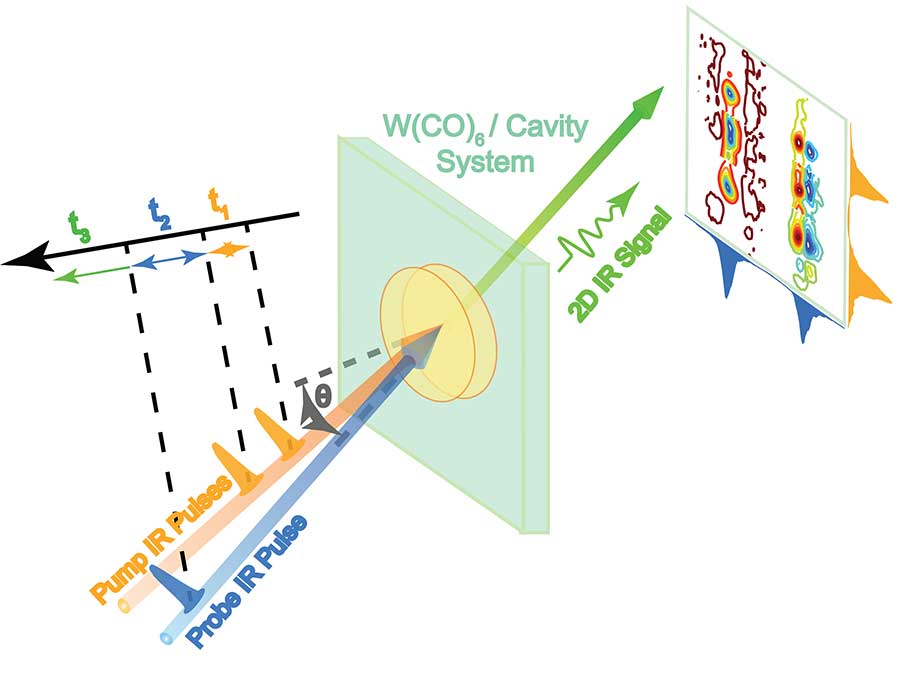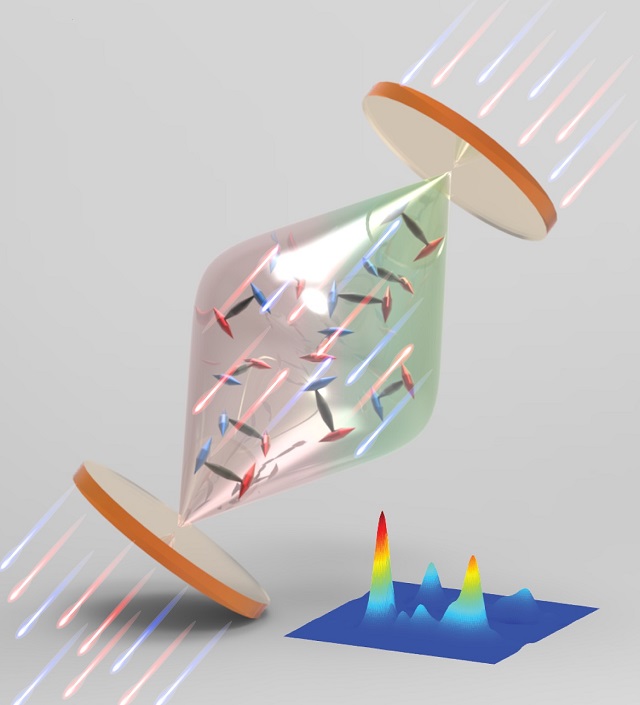
Chemists Work ‘In Between’ Light, Matter and Imaginary Cat to Improve Technology
Experimental research in physical chemistry draws upon famous thought experiment in effort to improve medicine, the oil industry and quantum communications
Published Date
By:
- Cynthia Dillon
Share This:
Article Content
University of California San Diego’s Wei Xiong studies the science of “in between.” Specifically, the physical chemist studies mixed states of light and matter in order to better understand how the two forms of energy interact and communicate. Xiong does this by mixing light and matter to create hybrid quantum combinations whose properties he and his team measure and analyze. Recent research by Xiong; Bo Xiang, a Ph.D. candidate in his group; and postdoctoral scholar Raphael Ribeiro, from the Joel Yuen-Zhou Group, was published by Proceedings of the National Academy of Sciences (PNAS) in an article titled, “Two-dimensional infrared (2D IR) spectroscopy of vibrational polaritons.”
From the Latin “polus,” meaning “the end of an axis, “polar” in science refers to a molecule, or a substance, with polar bonds. In the case of Xiong’s research this means “polaritons”—strongly coupled, mixed states of light and matter. Using the experimental method 2D IR, Xiong and his team monitored and manipulated the change of properties and energy levels of the hybrid matter/molecules. They found that a small variation, called “anharmonicity,” must be added to better describe the physics of molecular vibrational polaritons. With this finding, the researchers discovered a key component for understanding how molecules undergo chemical reactions and communications when they are in polariton forms. This complexity requires special tools like 2D IR to attempt to determine how hybridized light-matter particles talk to each other in order to transfer energy or influence each other’s properties—a desired outcome for enabling chemical reactions and increasing their efficiency.
“The ability to make a very specific type of chemical compound requires the ability to select components to achieve the desired result. Right now, we can’t do it,” said Xiong, “but, it’s important because of its application to medicine, to high selectivity chemistry in the fine oil industry and to quantum communication.”

2D IR pulse sequence and experimental illustration. Graphics by Bo Xiang
In Xiong's lab, the 2D IR device looks like an oversized black file cabinet, on its back, with equal-sized “drawers,” each with a handle at the top. Pulling up on a handle, like lifting a lid off a pot on the stove, Xiong revealed a series of small lenses and mirrors. The reflective tools comprised a miniature landscape featuring what looked like small-scale Bionicles and Transformers, all poised to transmit the next ray of laser light shot through rigged receivers within the dark and boxy space. The data generated was captured on computer and analyzed in the hopes of making progress toward new chemistry—novel medicines, customized drugs, new petroleum used in chemical compounds and even new encryptions.
This exercise of conducting 2D IR research with polaritons is what Xiong refers to as the perfect example of “Schrödinger's cat”—a famous thought experiment contrived in 1935 by Erwin Schrödinger, an Austrian quantum physicist. Schrödinger hypothesized what would happen to a cat placed in a sealed box along with a radioactive sample, a Geiger counter and a toxic potion. Schrödinger designed the experiment to illustrate what Xiong calls the stunning consequences of the “Copenhagen interpretation” of quantum mechanics, which states that a particle exists in all states at once until observed. If the Copenhagen interpretation suggests the radioactive material can have simultaneously decayed and not decayed in the sealed environment, then it follows the cat, too, is both alive and dead until the box is opened.
While it remains difficult to create a cat in such a mixed state, polaritons are hybrid particles whose light and matter components can communicate with each other at a very fast rate, and understanding how this sophisticated interaction occurs is essential to understanding how to apply mixed states of light and matter to modern science and technology.
The work by Xiong and his colleagues Yuen-Zhou and scientists in the Naval Research Laboratory is supported by the Air Force Office of Scientific Research Young Investigator Program Award (FA9550-17-1-0094) and by the Defense Advanced Research Projects Agency Young Faculty Award program (D15AP00107). The Yuen-Zhou Group is supported by an NSF CAREER Award (CHE: 1654732). Doctoral candidate Xiang acknowledges the Roger Tsien Fellowship from the UC San Diego Department of Chemistry and Biochemistry.
At UC San Diego, our research efforts are designed to change the world for the better—through new medicines, innovative technologies and more that will help address disease, global security, public policy, climate change and more.
Share This:
You May Also Like
Stay in the Know
Keep up with all the latest from UC San Diego. Subscribe to the newsletter today.



